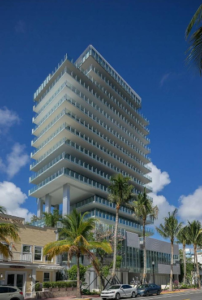
Miami Herald: Star architects’ dazzling condos are snagging big bucks. But so are towers by Miami’s best
MARCH 6, 2017

Glass, designed by Rene Gonzalez, brought $2,302 per square foot, in part due to its South of Fifth location.
The property is spectacular, 300 feet of oceanfront in Sunny Isles Beach. But when luxury condo developer Edgardo Defortuna acquired it, Sunny Isles was awash in deluxe new towers. Defortuna needed something special to outshine the competition.
He needed a star architect.
And so Defortuna found himself one day in Basel, Switzerland, at the studio of Jacques Herzog and Pierre de Meuron, the brainy architects famous for their austere virtuosity and, in Miami, for their singular designs for the Pérez Art Museum Miami and the origami-like parking garage at 1111 Lincoln Road. Defortuna was not sure what to expect, but their pitch bowled him over.
The architects presented a scale model of a conceptual design that pushed some inventive notions: They proposed tapering the tower and planting it an angle to the shoreline, so that the building would not block the afternoon sun on the beach. And they wanted to bury all parking underground, a costly and mostly untested idea so close to the shore. Instead of blocking beach views with a garage podium, the architects wanted the lobby to open up directly at ground level to the pool and the sea just beyond, a romantic throwback to the classic Miami Beach hotels of the mid-20th century.
READ MORE: Miami ‘has never seen a tower quite like this’
Defortuna thus became one of the first Miami condo developers to turn to that rarefied rank of international architects whose fame sometimes approaches celebrity — but whose fees and high-flying creative impulses inflate construction budgets — to tackle that most prosaic of Miami housing types, the high-rise condo.
Defortuna’s Jade Signature, now under construction, is just one of around a dozen ultra-luxury condo projects in Miami-Dade that bear the imprimatur of a celebrated architect. Other developers have turned to such notables as the late Zaha Hadid, Rem Koolhaas’ Office for Metropolitan Architecture, Norman Foster and Jean Nouvel, all of them winners of the Pritzker Prize, the profession’s top honor.
But along with the big names come big egos, bigger construction price tags and, sometimes, big headaches, leading some skeptics to wonder: Are the “starchitects” worth their salt? Does architectural fame really help sell an extravagantly priced new condo?

For Defortuna, the gamble has paid off. The 192-unit Jade Signature was markedly more expensive to build than a comparable luxury condo, as much as 20 percent more, he said. That’s mainly because of the underground garage, which cost double what an above-ground structure would have. Other expensive elements include cantilevered balconies and exterior support columns in varying, undulating shapes that define the tower’s architecture, he said.
Sales have exceeded even his immodest target of $1,300 a square foot and, with just 12 units left, are averaging $1,500 per square foot even as the market slows down, he said.
“If you ask me, would I do it again? I would do it again in a second,” Defortuna said of hiring star-quality architects. “It’s hard to put a dollar value to what they bring. This experience has been very rewarding. I am 100 percent sure people are going to love living there.
“And that’s eventually what it’s all about. This is not a monument, this is a place you will be living in.”

But it’s also a commercial enterprise, and in a hyper-competitive luxury market, star architects, and the high-concept design flourishes they bring to a project, can provide an edge that draws wealthy buyers and puts a project over.
Interviews with developers like Defortuna and a review of recorded and reported sales in the current cycle suggest that edge is real, with some qualifications. The figures suggest a clear price premium for condo projects now in sales that were designed by renown architects over much — but by no means all — of their more-conventional high-end competition.
Units in the first star architect condo to open for occupancy in this cycle, Foster + Partner’s beachfront Faena House in mid-Miami Beach, sold for a mind-boggling $3,974 a square foot, according to recorded sales figures compiled by CraneSpotters.com.
That far outstrips the already-lavish $1,009 per square foot attained more recently at Terra Group’s Grove at Grand Bay in Coconut Grove by young Danish superstar Bjarke Ingels, or the even more bountiful average of around $1,500 per square foot reported by Jade Signature and Hadid’s One Thousand Museum in downtown Miami.
Those latter figures easily outdo CraneSpotters’ average new condo sales east of Interstate 95, at $896 per square foot. They also outpace the prices garnered by competitors such as Echo Aventura, designed by the well-known if perhaps not star-level architect Carlos Ott, which sold for $699 a square foot, or the Reach and Rise towers at Brickell CityCentre, designed by Miami-based luminaries Arquitectonica, which sold for $699 and $735 a square foot, respectively.
But the Pritzker laureates hardly have the high end all to themselves.
In fact, luxury condo projects by some solid, even stellar locally based architects like Arquitectonica or unhyped Sieger Suarez Architectural Partnership often match, and even exceed, the prices commanded by most of the star-architect condos, the review shows. Some of those top prices seem determined in large part by that old real-estate saw — location, location. And some have seen boosts by association with classic brands with a strong international following, such as Ritz-Carlton.
It turns out that the selection of an architect is only one element in a complex formula that determines sales success for a luxury condo.
Look no farther than Château Group-Defortuna’s Ritz-Carlton residential project in Sunny Isles, on the same beachfront as Jade Signature. Designed by Arquitectonica — an international behemoth that is globally renowned, but unlike most star architects, routinely designs mid-market projects as well — the tower is commanding close to $1,600 per square foot, though the units are smaller than those at Jade Signature, Defortuna said.
Defortuna attributes its appeal to “Ritz-Carlton junkies” who appreciate the brand’s attention to detail, as well as a dazzling design by Arquitectonica’s principal, Bernardo Fort-Brescia, who beat two other firms in a competition for the job.
“There is a perfect architect for every project, if you know what you need,” Defortuna said. “Bernardo really hit it out of the park. Some luxury buyers will be drawn to the architecture and the name, and others recognize the beauty of the buildings, or just like the brand. We’ve tried to cover the entire spectrum.”
Other new Arquitectonica designs are also top performers, the CraneSpotters list shows: Units at Regalia, in Sunny Isles Beach, sold for $1,616 a square foot; at Oceana Bal Harbour at $1,849 a square foot; and at Fendi Château, also in Sunny Isles, at $1,676 a square foot.
Equally or even more-stellar results came from smaller, boutique projects in Miami Beach’s hotter-than-hot South of Fifth neighborhood, in part because of their cozy exclusivity. Terra Group’s Glass, designed by prominent Miami architect Rene Gonzalez, sold out its 10 units at $2,302 a square foot. Nearby, Aria Development’s 321 Ocean, by Mexican star architect Enrique Norten, with just 21 units, has sold at $1,721 a square foot.
Then there’s the newest wrinkle in Miami’s luxury condo market: Branding projects with famous names from the worlds of fashion, product and automobile design, such as Fendi, Missoni and Armani. The interiors of the Missoni Baia tower, in Miami’s Edgewater neighborhood, will incorporate the Italian house’s colorfully patterned designs and furniture. At the Armani/Casa tower in Sunny Isles Beach, every fixture has been designed by the firm, “down to the faucets and the bathtubs,” said Carlos Rosso, president of developer Related Group’s condo division.
Dezer Development’s Porsche Design Tower, by Sieger Suarez, features innovative elevators that lift your car into your living space, and units there have sold for an average $1,658 a square foot, according to CraneSpotters — never mind that the critics have not exactly swooned over its architecture.
ArchDaily.com, an architecture website, called the Porsche tower the most significant new tower in Miami after Hadid’s One-Thousand Museum because of its “Dezervators.” But it also called its architecture “chunky” and “disappointingly nondescript,” especially in comparison to Hadid’s “stunning” design.
But that goes to show that in the Miami market the architecture and the architect’s name are less significant than other factors, said Peter Zaleswki, president of Condo Vultures, which compiles the CraneSpotters list.
“A condo is a condo,” Zalewski said. “It’s concrete, rebar and air space. The only thing that really differentiates them is view, amenities and maintenance fee. Buyers want functionality.”
Local developers began turning to big architectural names at the beginning of the cycle in 2011, when they needed a lure to persuade buyers to put down 50 percent deposits, a tactic designed to avoid another speculative bubble, he said.
“The only way you could get someone to put 50 percent down was to offer something distinct and unique, and to try to build up this idea that an architect would add value, like a Picasso or a Jackson Pollock,” Zalewski said.

That name-brand architecture has been a particularly strong selling point with European buyers, though not so much with American or South American customers, said Manuel Grosskopf, principal of Chateau Group, which has relied on Arquitectonica and Miami architect Kobi Karp for its three local projects.
But Zalewski wagers that once units in star-architect condos are resold, the price premium will begin to vanish, since they’re traded largely as commodities based on market value.
In fact, Related’s Rosso points out, units in one of the luxury projects the firm built in the previous cycle, Apogee in the South of Fifth neighborhood, designed by Sieger Suarez, routinely re-sell for three times what One-Thousand Museum is getting. The UrbanResource.com website puts the average current asking price in the building at $3,478 per square foot.
“What does that mean in relation to the architect? Nothing,” Rosso said, stressing that the building’s design is first-rate. “It means in that location, it commands a lot. It’s all in the timing and the quality and what you ask the architect to do. It’s not always the name of the architect” that commands top dollar.
Related, Miami’s dominant condo developer, turns to Arquitectonica so often that the firm is virtually the house designer. It has used star architects in only a handful of instances, when partners wanted it.
THERE IS A PERFECT ARCHITECT FOR EVERY PROJECT, IF YOU KNOW WHAT YOU NEED.Luxury condo developer Edgardo Defortuna
To win over Giorgio Armani to design the interiors for a Sunny Isles tower, Rosso said, Related had to enlist veteran star Cesar Pelli, also designer of the Arsht Center. And Terra Group, Related’s partner in Park Grove, chose Koolhaas’s OMA to design the three-tower condo in Coconut Grove after running a public competition featuring a handful of the profession’s biggest names.
Those high-level architects, Rosso said, constantly push the conceptual envelope.
“It’s a very interesting clash,” he said with a laugh. “We want them to surprise us with something that is new. Then we have to bring them back to reality.”
A tour of the first two Park Grove towers now under construction demonstrates how architects of the caliber of OMA can bring something superlative in conception and execution to a project. Inspired by the surrounding Grove, the design of the tower and its flowing podium takes on sinous organic shapes in concrete that flow in and out of lobbies and common spaces. One dramatic gesture: a sunken amphitheater on the amenity deck that doubles as a light well for a vast lobby. Rosso says OMA insisted on the amphitheater.
“They were sort of adamant. But this is what makes this space magical. These are museum-quality spaces,” Rosso said, adding that the deck and common spaces “cost a fortune.”
The stars’ schemes are often sensational: Ingel’s twin twisting towers next door at Grove at Grand Bay. Hadid’s alien-like exoskeleton at One-Thousand Museum. Jean Nouvel’s jungle-in-a-lagoon design for a boutique mid-rise condo on Biscayne Bay in Miami Beach.
The costs, developers say, can be daunting.
At One-Thousand Museum, the swooping exterior superstructure that Hadid designed required contractors to devise an innovative construction approach and cost twice what a conventional structure would have, said co-developer Louis Birdman. But the development team figured they needed someone like Hadid, who had not built in Miami previously, to make the most of their site opposite Museum Park. They got all they bargained for: a helipad at the top, and a glassed-in swimming pool and spa suspended near the tower’s top.
To make up for the additional cost, the developers opted for a few very large units, just 83 in a 62-story tower, that would command premium prices in spite of the downtown location. The smallest unit is 4,600 square feet and, because the exoskeleton eliminates the need for interior columns, feels even bigger.
“There really is no competition for that project,” Birdman said. “We didn’t want to be one of 10 very similar projects.”
Given the high costs, the high sales values don’t translate into profit margins significantly larger than they otherwise would have been, Birdman noted. But there were other advantages — for instance, in marketing and speed of sales, he said.
Because Hadid, as the world’s only superstar architect, had an especially devoted following, her name proved magical, Birdman said. There was free publicity in the form of news reports around the world. Buyers came from countries where the developers had not even thought to market the project, like Norway, Finland and Turkey, he said.
“They were attracted to the project because of Zaha. That’s what brought them in the door,” Birdman said. “It’s hard to put a value on what that added. ”
There are even more star-quality projects about to break ground. Terra Group has hired its third celebrated architect, Pritzker winner Renzo Piano, for a beachfront condo in North Beach. Work is about to start on New York-based JDS Development Group’s Monad Terrace, by the Frenchman Nouvel, along West Avenue.
JDS principal Simon Koster said his team chose Nouvel because the site seemed to demand the qualities the architect is known for — the transparency of his designs, the way he plays with natural light, and his ability to fuse nature and an urban setting. That level of design, he said, appeals to the discerning clientele they’re aiming for, even if the buyers don’t necessarily know Nouvel from Koolhaas or Frank Lloyd Wright.
“It’s not about a nicer bathroom or a nicer kitchen,” Koster said. “It’s about being a whole lot more thoughtful about the experience. It’s all about the views back over the bay to downtown, and across South Beach to the ocean. Water, reflections and light — there’s not that many architects around the world who have his level of execution in bringing all those factors together. We wanted someone who would absolutely nail it.”
But is the starchitect blush starting to wear off? Zalewski and other observers think it might be, noting the turn to fashion designers with even bigger worldwide followings than those of star architects.
When Related and Dezer brought in Pelli to work on their Armani/Casa condo collaboration, there was little doubt who the headliner would be.
In the project’s own website, Pelli, the architect of the twin Petronas Towers in Malaysia, until a decade ago the tallest in the world, takes second billing. His name is right under Armani’s, in small print.

